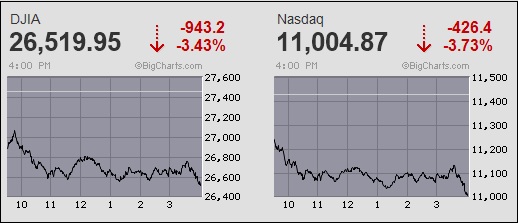By Pam Martens and Russ Martens: October 29, 2020 ~
On Monday the Dow Jones Industrial Average closed down 650 points. On Tuesday, the Dow lost another 222 points. Yesterday, the Dow closed near the lows of the day, plunging 943 points by the closing bell. The pain was broad-based with only one of the Dow’s 30 component stocks closing in the green: that was The Travelers Companies, a property and casualty insurer.
Market sentiment has turned bearish in no small part because of the unrelenting pandemic, the lack of a new stimulus bill from Congress, and the selloff in oil. All three are interrelated. As of 7:40 a.m. this morning, West Texas Intermediate (the U.S. domestic crude) was trading at $35.90, down 4 percent on the day and down 10 percent from its $40 handle last week.
The price of oil is a heavy influencer of market sentiment for the following reasons. First, it’s a barometer of the prospects for economic growth. If consumers are spending then factories are humming and using more energy. If the economy is growing, more people are working and using energy to drive to work. Conversely, if COVID-19 cases are growing, along with lockdowns in Europe and the potential for more business shutdowns in the U.S., less energy is needed.
Yesterday, French President Emmanuel Macron announced that because of growing COVID-19 cases, the country will begin a four-week lockdown starting Friday. Non-essential businesses, bars and restaurants have been ordered to close.
German Chancellor Angela Merkel also indicated that rising COVID-19 cases in that country would require a lockdown beginning this coming Monday. Restaurants and bars are also being ordered to close and residents were advised to “keep their contacts to an absolute minimum.” Merkel said Germany would reassess the situation in two weeks.
As that news was playing out, CNN reported that 40 states in the U.S. are seeing rising numbers in COVID-19 cases with hospitalizations spiking in the Midwest. CNN wrote that “Indiana and Wisconsin reported their peak levels of coronavirus hospitalizations. And Kansas saw the most ICU hospitalizations of the virus in one day, the same day the state surpassed 1,000 deaths since the pandemic began.”
On top of the slack in demand for oil, there is the perfect storm of increased supply pushing down prices. The end of a fuel blockade has resulted in rising oil output from Libya, thus further depressing prices.
When crude dips below $40, there is spillover to the banks that hold loans to energy companies that are more at risk of bankruptcy filings. The heavily-indebted U.S. shale drillers struggle to produce a profit with crude below $40 a barrel. Thus, there was also a sea of red in the share prices of the big Wall Street banks yesterday.
Banks are also looking at growing losses from declines in the value of commercial real estate where they hold significant loans. As more and more employees work from home to stay safe during the pandemic, less commercial office space is needed.
The Financial Times quotes Adam Slater, the lead economist at Oxford Economics, as stating: “It’s possible that demand for office, retail and hotel space, and even urban multifamily housing may never recover to pre-crisis levels.”
FT also notes that Jeremy Kelly, Director of Global Research at JLL has reported “a contraction in leased office space of 59 per cent for London, 66 per cent for New York and 77 per cent for Tokyo in the second quarter of this year, compared with the same period in 2019.” Those are staggering numbers and raise the question as to why we are not seeing more loan-loss reserves being taken by the big Wall Street banks.
This morning, the market is struggling for direction before stocks open for trading at 9:30 a.m. Dow futures were up 66 points, then down 100, now up 43 points at 9:02 a.m. As expected, a robust number for third quarter GDP was reported this morning, at a rollicking rate of 33.1 percent, annualized. Unfortunately, that’s the past and the stock market is forward-looking.
The good news on the third-quarter GDP follows a GDP decline of 5 percent in the first quarter and an unprecedented decline of 31.4 percent in the second quarter. Both figures are annualized.


